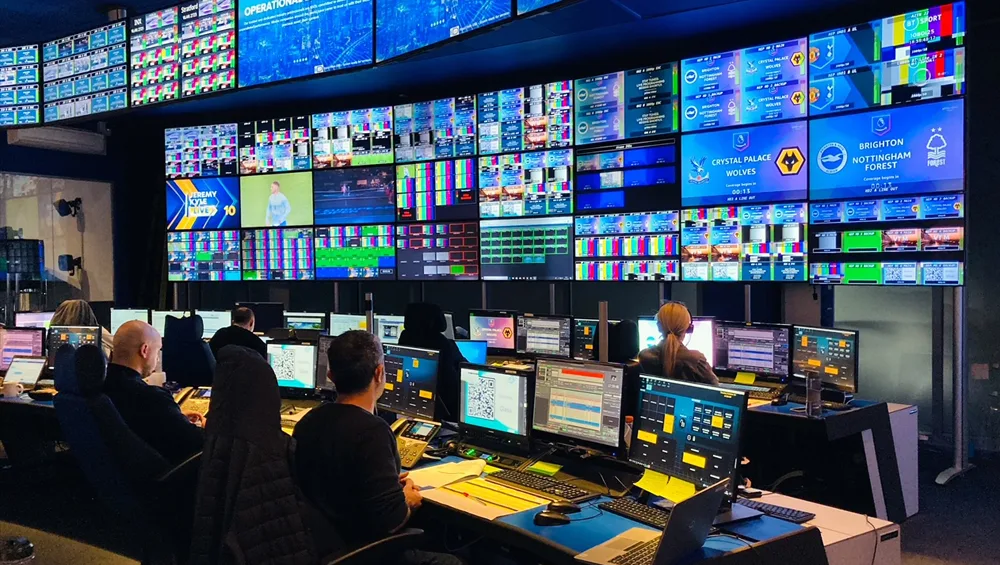
Hubbing Persists Despite Cloud Pressure

In a broadcast world undergoing rapid change due to advances in IP distribution and public cloud technology, one old-school technology model persists. That is a practice called “hubbing,” also known as “centralcasting,” in which a station group streamlines its operations by consolidating master control equipment and personnel in centralized or regionalized technical centers that support multiple stations.
Hubbing dates all the way back to 1999, when now-defunct Ackerley Group launched its “digital centralcasting” clusters to centralize master control, traffic and accounting functions. Over the past two decades a number of major station groups followed, including the NBC-owned stations which first created their own hub in 2000 and then in 2009 shifted to an outsourced model with Encompass Digital Media in Atlanta; the ABC-owned stations, which moved to Encompass in 2014; and E.W. Scripps and Tegna, which built their own on-premises regionalized and centralized facilities, respectively, to handle master control functions. (Both NBC and ABC stations have subsequently left Encompass to run in-house master control hubs.)
With major programmers having proven that they can playout both linear and FAST channels from the public cloud using control software from vendors like Evertz and Amagi, the long-term viability of station groups maintaining physical hubs with on-premises hardware would appear uncertain. But both vendors and broadcasters say that hubbing isn’t going away anytime soon. That’s mainly because most engineers feel the cloud isn’t quite ready to handle the dynamic nature and complex timing requirements of call-letter stations that frequently break into scheduled programming with live news cut-ins. Some also express concern about centralizing their content in cloud storage in case of connectivity failures or other emergencies.
There are two main hubbing models for groups today. One is the fully centralized, or “streaming,” model, where a large central facility with reams of playout servers pumps out programming directly to stations over high-speed connections. The other is the “remote control” or “edge” model, where master control operators in a central hub, or several regional hubs, remotely control playout from on-premises servers located at each station. Tegna and Entravision use the first model, while Fox Television Stations employs the second.
Mixed Models
Nexstar Media uses a mix of both models to handle playout across its 200 stations. Its preference is the remote control model wherever possible. But some stations don’t have the necessary gear and/or space onsite to support it, such as satellite dishes to take down network programming. So, those stations are supported in a streaming model, though most have the ability to switch locally to live local newscasts.
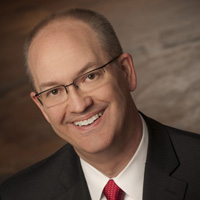
Blake Russell
“I do favor the edge model, because it keeps the content on the station side, it keeps the money in-house,” says Blake Russell, Nexstar EVP for station operations and content development. “So, if anybody were to get a backhoe that would cut an IP path or a piece of fiber in two, then the content is still there and personnel at the station could continue to manage that list. And we could continue to play out for that outage period. Whereas on the streaming model, we’ve got to do some other things.”
Nexstar had around a dozen regional hubs after it acquired Tribune in 2019 and some stations that were still 100% local. The company has consolidated the hubs significantly since then and transitioned its last standalone station to a hub-supported operation about six weeks ago.
“There’s a total of five hubs,” Russell says. “Four of those address content as a central ingest point. They bring the content in, time it and track it. And then they’ll go ahead and feed that out, whether it’s to a particular hub that’s a streaming model, or to a particular edge site.”
Nexstar never considered using outsourced hubbing with Encompass or any other third-party firm for its stations, Russell says, though the company is currently using Encompass to handle playout of The CW Network and CW Plus (and is actually expanding its footprint there with additional uplink/downlink capabilities for live sports). It also isn’t using the cloud in any capacity, neither content prep nor playout.
“The cloud’s not there yet as far as costs,” Russell says. “It’s a very, very expensive proposition when you step back and look at that versus what we’re doing now. Not only that, it starts with really having the ability to control your destiny — because I would rather have no connectivity to anybody but I’m still able to play my spots and I’m still able to put food on the table for our 13,000 employees.”
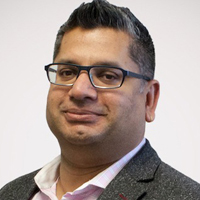
Mo Goyal
Mo Goyal, Evertz senior director of business development, notes that labor costs are usually the biggest reason to pursue hubbing in the first place. But the geographic location of stations can also make a big difference in connectivity costs, with bandwidth being more expensive in less populated rural areas than in in urban centers. That may steer a broadcaster toward a certain location for a hub, or toward a remote-control model versus streaming.
“It really just becomes a question of network connectivity and cost,” Goyal says.
Entravision is successfully using Bitcentral’s master control software in a streaming model to pump out 58 unique program streams from a central playout center in McCallum, Texas. But other Bitcentral customers are exploring edge models for playout, or even considering the cloud, says Bitcentral COO Sam Peterson.
“If there’s a trend, it’s that there’s not a single trend except for to drive for efficiency and drive for flexibility,” Peterson says. “That’s what everybody’s looking for. They want to be efficient, but they still want to be flexible.”
Rooftop Consolidation
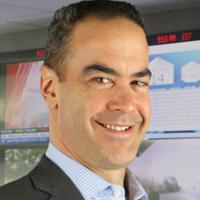
Jason Kornweiss
Jason Kornweiss, VP of strategic solutions for systems integrator Diversified, agrees that broadcasters are continuing to pursue hubbing, but says there is no strong agreement in their approach.
“There are stations with internal hub and spokes that are exploring outsourcing, and almost equally, station groups that have formerly outsourced bringing it back in house,” Kornweiss says.
He points to the NBCU Local station group, which now includes both the NBC and Telemundo stations. In 2015, it moved out of Encompass to run master control from the “NBCU Hub at Dry Creek” within the Comcast Media Center (CMC) building in Centennial, Colo., where it resides today alongside the NBC and Telemundo networks and some NBCU cable properties (CMC, which competes with Encompass, runs outsourcing services for other programmers on a separate floor).
Another example is the ABC Television Stations, which last year moved master control from Encompass to Digital Center 3 (DC3), Disney’s new technical hub for playout, transmission and media operations in The Woodlands, Texas.
For many station groups, Kornweiss says, linear playout has become a commodity function that can best be managed by a third party, allowing them to focus on monetizing their content. But the math is different for media conglomerates that own a large number of diverse properties and want to consolidate their broadcast and digital operations, as Disney did with DC3.
“The networks are looking at network and owned-station consolidation — how do you get all of them into one facility,” he says. “If they are not outsourced and they’re insourcing them, how do you get economies of scale of running network and stations under the same rooftop? Rooftop consolidation is the key for all networks in all cases. Focused rooftops that are production-only and playout-only as opposed to the way things used to be, which was everybody’s in one big bucket.”
Encompass Maintains Its Heading
While that trend would seem to hurt Encompass, CTO Alan Young says the company’s hubbing business, driven by hundreds of trained staff in Atlanta, continues to grow.
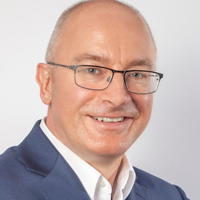
Alan Young
“Encompass still operates the largest centralcasting operation in North America,” Young says. “And the reason for that, it’s economies of scale, the ability to do all of the ingest, centralize the master control operators, and having a pool of people that are trained on how to do the pretty complex operations that most of the stations in the U.S. have. They have to do live breaking news pretty much anytime, and they have live premium sports events. And so, the economies of scale are there, and as a result of that we are still growing that business.”
For station groups using outsourced hubbing with Encompass, the opex savings are 20% or more annually compared to doing it themselves, Young says. Regional sports networks that hub their operations can save even more.
Encompass plans to move from on-premises technology to the public cloud wherever it operationally makes sense, Young says. But with respect to the cloud’s potential, he says that “one thing people need to understand is that playout is not just one workflow.” Encompass actually breaks its playout workflows into four categories: FAST channels; “multichannel cable networks”; sports channels; and local stations.
FAST channels have simple branding, no live content and generally are comprised of archived content, Young says, which makes the cloud a perfect playout solution. He says that is why Encompass announced a partnership with Amagi at NAB to pursue the FAST market together.
“Multichannel cable networks” have more complex branding and graphics as well as more complex schedules, including occasional live programming. But that live programming tends to be more “simple playlist live,” Young says, with shows like Reelz’ On Patrol: Live that air the same time each week.
“There’s very little for us to do other than take the live feed and stick it in,” Young says, which is why Encompass is already starting to move some cable networks such as A&E to the cloud.
Sports channels, with a high volume of live game coverage that includes dynamic ad breaks being called from a production truck and complex switching between markets, are infinitely more complicated. But the most complex category are local stations, Young says, because they can go live “at the drop of a hat.”
“So, you literally have to be able to book the feed, get it in, put it on air, manipulate the playlist so it still times out properly, and do it for many multiple stations at the same time while others are doing something else that’s live,” he says. “When it comes to the cloud, the complex station operations are just not ready for the cloud yet in our opinion. We’re still doing that on prem.”
Ingest As A First Step Into Cloud
Beyond centralizing playout and reducing headcount, one of the biggest side benefits of hubbing for groups has been the “de-duplication” of tasks like the content prep and QC of syndicated programming and commercials through the centralization of content ingest, preparation and ingest.
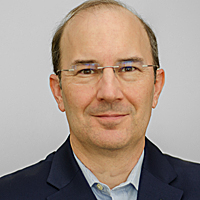
Sam Peterson
“If I have 26 stations in my group that all carry Wheel of Fortune, granted we don’t prep tape anymore, but there’s still a QC function,” Bitcentral’s Peterson says. “I do that one time instead of 26 times. That’s still a benefit in pooling that work together and doing the same work for multiple stations at one time with one group of people, with one pool of equipment and/or resources.”
Nexstar has centralized those ingest and content prep functions with on-premises hardware at its regional hubs, while Sinclair has created similar functionality with its “content pipeline” in the AWS cloud. As he looks towards the next big hubbing trend, Diversified’s Kornweiss thinks that more groups will follow Sinclair’s lead and turn to the cloud to streamline their ingest functions while most playout remains on-prem for the near term.
“The cloud is really the catalyst for the ingest consolidation,” Kornweiss says. “For master control technology, ingest in the cloud is really the driving factor, more so than playout right now. Playout is a very real thing in the cloud for very specific applications, and we’re seeing improvement in that space. But ingest is a slam dunk, for lots of reasons. You’ll have operator workstations on premise and they’ll hit a shared storage center that’s agnostic to wherever your playout facility lives.”
































Comments (0)